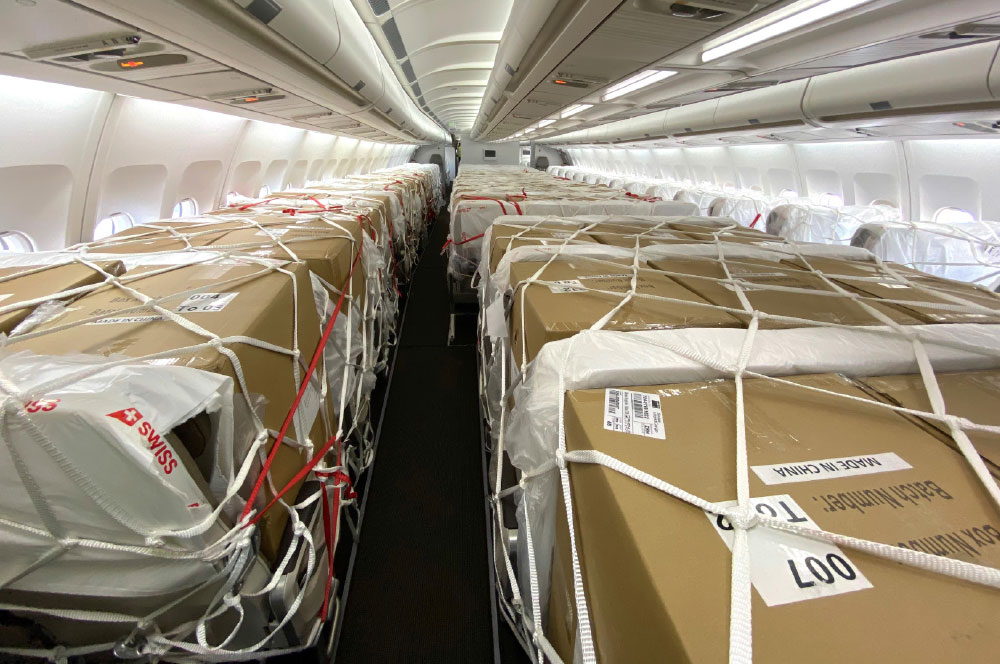


The first cargo flight took place in 1910 in Ohio, by a company requesting to carry two bolts of silk (90 kg) transported by the Wright Brothers to Columbus. Since that day, cargo carried on airplanes has become an economically important contribution for airlines.
As a result of the pandemic that we are now experiencing, a new era has started in which airlines that ceased passenger flights have started to carry cargo with passenger aircraft. In the details of the news about travel restrictions and flight bans, we read that cargo flights are exempt from this situation. Okay but why is this the case? Let`s take a look at the underlying reasons…
Due to the fact that passenger demand has dropped sharply to near zero, the industry has been hit extremely hard. Sectoral reports show that the number of passenger aircraft that have been grounded has reached nearly 16 thousand. This means that more than 60% of all airplanes are now on the ground.
Even global giant airline companies have suspended 90% of their capacity and many airlines had to cancel all their flights in line with government decisions. The picture is so dark and painful that both airlines and manufacturers have asked for government bailouts to survive.
While airline companies across the world cancel their flights to a large extent and ground aircraft in their fleets, they are attempting to overcome this crisis by carrying out cargo operations with passenger aircraft, as an alternative step.
The approach of using passenger aircraft for transporting cargo has become accepted and applied by almost all actors of the industry.
Passenger airplanes in fact carry more than the passengers, their luggage, and viruses. A significant volume of cargo is also carried in the cargo compartments of all airplanes that we usually fly. For airlines, the cargo transported in the cargo compartments of passenger aircraft is one of the easiest methods of generating regular additional revenue. For example, passenger airplanes in Asia carry about 45% of the air cargo capacity. This important work share helps businesses regulate all transportation processes globally. Especially in transatlantic routes, this rate may reach as much as 80%.
For example, due to Trump`s decision to ban all flights from EU countries to the USA for 30 days, not merely passenger flights were affected. A huge capacity problem also emerged in terms of cargo transportation.
Because of the capacity problems in cargo transportation, doing the same business with cargo planes nearly doubled shipping costs. Moreover, due to increasing demand shipping time has also doubled.
Passenger aircraft are used to transport cargo in order to achieve a slight improvement in financial outlook and generate additional revenue. With the gradual normalization of the factories in China, which reduced their production capacities to almost zero by the end of January, it is impossible to meet transportation demand by cargo planes alone.
Considering the fact that oil prices have fallen to the lowest levels in recent years, the requirement to pay employee salaries regardless of whether they fly or not, and with the high freight costs, airlines regard cargo transportation with passenger planes as a lifeline support amid the pandemic.
The resulting situation not only creates a small boost in vitality for the waning global economy, but also provides some liquidity for the airlines who have had very little relief during this crisis.
We experienced similar practices before during the 2002 SARS crisis and the West Coast port strike in 2015 in the US. This step that has become a natural consequence of the Covid-19 outbreak in the industry.
The new aviation phenomenon Preighter
Many airlines all over the world are finding different ways to turn their passenger planes into freighters. Lufthansa CEO Carsten Spohr, has become the first to give the new aviation`s phenomenon name: Preighters (a combination of passenger aircraft and freighter)
Passenger cabins are not designed for all cargo configurations, but the rules allow goods to be carried under the seats, in stowage bins or storage closets if all normal requirements for the safe carriage of cargo are followed. Putting boxes in the seats or removing the seats requires special permission.
The Federal Aviation Administration issued guidelines for commercial carriers to follow if they transport cargo in stowage bins, passenger seats or on the floor, with the seats removed. The safety alert essentially tells carriers they can carry shipments up top as long as they adhere to all regulatory requirements for the safe carriage of cargo.
The safety alert instructs operators how to assess the risk for carrying goods in the passenger space, including weight and balance, fire detection and suppression and hazardous materials considerations. Carriers have to verify the contents to make sure no dangerous goods are carried in the upper deck.
The FAA recommends that one or more crew members travel in the cabin with the cargo to respond to any potential fire, since fire suppression systems are not present as they are in the cargo hold of modern widebody aircraft. Passenger cabins only have fire extinguishers.
Airbus developed a modification for A330 and A350 family aircraft which will enable airlines to install freight pallets directly onto the cabin floor seat tracks, after removal of the economy-class seats.
This solution helped with the airlines’ own business continuity, and also alleviate the global shortage of ‘belly-freight’ air cargo capacity due to the widespread grounding of long-haul aircraft in the context of the COVID-19 pandemic.
The modification is packaged for operators as an Airbus Service Bulletin (SB). Under this arrangement Airbus defines the engineering workscope and also manages the process for obtaining the one time certification from the European Union Aviation Safety Agency (EASA).
Franco-Italian aircraft manufacturer ATR is one of a number of companies offering flexible cargo capacity solutions to easily reconfigure full passenger jets to cargo or a mix of both.